
Edith Dircksey Cowan was an Australian social reformer who worked for the rights and welfare of women and children. She is best known as the first Australian woman to serve as a member of parliament. Cowan has been featured on the reverse of Australia's 50-dollar note since 1995.
Hale School is an exclusive independent, Anglican day and boarding school for boys, located in Wembley Downs, a western suburb of Perth, Western Australia.

York is the oldest inland town in Western Australia, situated on the Avon River, 97 kilometres (60 mi) east of Perth in the Wheatbelt, on Ballardong Nyoongar land, and is the seat of the Shire of York.
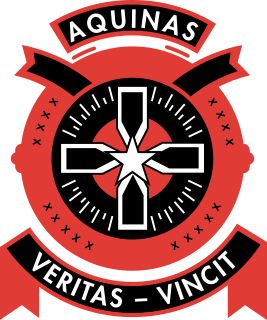
Aquinas College, locally abbreviated as Aquinas, is an independent Roman Catholic single-sex primary and secondary day and boarding school for boys, located at Salter Point, a suburb of Perth, Western Australia.

Sir Edward Horne Wittenoom KCMG was an Australian politician who served intermittently in the Legislative Council of Western Australia between 1883 and 1934, including as President of the Legislative Council from 1922 to 1926. He sat in the Legislative Council from 1883 to 1884, 1885 to 1886, 1894 to 1898, 1902 to 1906, and finally from 1910 to 1934. Wittenoom was a minister in the government of Sir John Forrest, and was also Agent-General for Western Australia between 1898 and 1901.
Richard Roach Jewell was an architect who designed many of the important public buildings in Perth during the latter half of the nineteenth century. He was employed to supervise many major building projects around England, churches in Bristol, Cardiff, Clifton, Eye, Horsley and Stroudswater. As well as churches he also supervised construction of Stanstead College, a military prison in Gosport and fortifications at Portland Castle and Southsea Castle. He was also employed as a clerk of works in the offices of Sir Charles Barry.

St Mary's Cathedral, Perth, officially the Cathedral of the Immaculate Conception of the Blessed Virgin Mary, is the cathedral church of the Roman Catholic Archdiocese of Perth, and seat of its Archbishop, currently Timothy Costelloe.
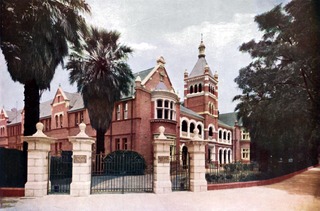
Christian Brothers College (CBC), informally known as CBC Perth or The Terrace was an Independent school for boys situated on St Georges Terrace in the centre of Perth, Western Australia. The college opened in January 1894, and the college was a founding member of the Public Schools Association in 1905. The college was the second high school (1894) and the second boarding school (1896) in Western Australia. In 1938 boarders and some day students at CBC moved to the new Aquinas College campus at Salter Point. Brother C.P. Foley, who was the headmaster of CBC Perth and who at the same was the first headmaster of Aquinas took with him the Christian Brothers College crest and colours, honour boards, and Public Schools Association membership. Brother Foley insisted the heritage of CBC Perth from 1894–1937 belonged to Aquinas. To further enhance Aquinas as the premier the Christian Brothers College, the main building at Aquinas was designed in the Federation Arts and Crafts architecture of CBC Perth. Meanwhile, although most of the day students remained at CBC Perth, numbers were depleted and the college immediately accepted an overflow of students from St Patrick's Boys School on Wellington Street. CBC Perth continued as a day school from 1938–1961. In 1962, the students and staff of CBC Perth moved to a new site on the East Perth foreshore and the college was renamed Trinity College.

Perth Institute of Contemporary Arts (PICA) is a contemporary visual and performance arts venue located in Perth, Western Australia.

East Perth Cemeteries was the first cemetery established for the Swan River Colony in 1829 in East Perth, Western Australia. It is estimated that as many as 10,000 people were buried there between 1829 and 1919 in seven independently administered denominations or sections which is why the place is known as 'East Perth Cemeteries'. Only around 800 gravesites have been identified. A large section of the original site has since been built over, leaving about 5 hectares remaining.

The Deanery is located on St Georges Terrace, at the intersection of St Georges Terrace and Pier Street, Perth, Western Australia.
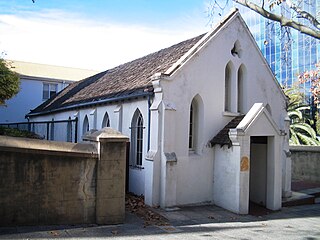
St John's Pro-Cathedral is located at 18 Victoria Avenue in Perth, Western Australia. It is the earliest Roman Catholic church building in Western Australia.
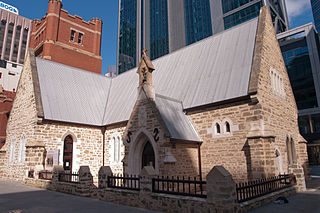
The Old Perth Boys School, located at 139 St Georges Terrace, Perth, Western Australia, is the earliest government school building in Western Australia. The single-storey limestone building was designed by William Ayshford Sanford in 1852 and is a significant example of a colonial building constructed in Perth from the mid-nineteenth century.

Wesley Church is a Uniting Church in Perth, Western Australia, located at the corner of William Street and Hay Street. It is one of the oldest church buildings and one of few remaining 19th-century colonial buildings in the City of Perth.

Bishop's House is a heritage-listed former residence of the Anglican Bishop of Western Australia at 78 Mounts Bay Road, Perth, Western Australia.
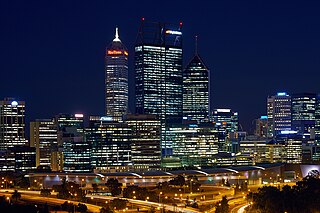
Perth is a suburb in the Perth metropolitan region, Western Australia that includes both the central business district of the city, and a suburban area spreading north to the northern side of Hyde Park. It does not include the separate suburbs of Northbridge or Highgate. Perth is split between the City of Perth and the City of Vincent local authorities, and was named after the city of the same name in Scotland.

St George's House is located at 237 St Georges Terrace in Perth, Western Australia. It was also previously known as Cardigan House, Bishop's Grove and Ingle Hall.

Trinity Church is one of the oldest church buildings in the City of Perth, and one of the few remaining 19th-century colonial buildings in the city. It is located at 72 St Georges Terrace in Perth, Western Australia.

St Mary Star of the Sea is a parish of the Roman Catholic Church in Peppermint Grove, Western Australia. Located in the Archdiocese of Perth, it is dedicated to Our Lady, Star of the Sea.

Milligan Street is a street in Perth, Western Australia that runs from St Georges Terrace to north of Wellington Street. The northern section provides access to the Perth Arena carpark and Telethon Avenue; there are also dedicated Transperth bus roads connecting to the northern end, south of the Fremantle railway line.





















